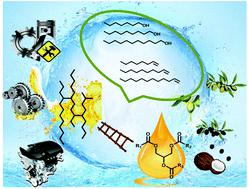当前位置:
X-MOL 学术
›
Green Chem.
›
论文详情
Our official English website, www.x-mol.net, welcomes your
feedback! (Note: you will need to create a separate account there.)
Conversion of lipid into high-viscosity branched bio-lubricant base oil
Green Chemistry ( IF 9.3 ) Pub Date : 2020-07-03 , DOI: 10.1039/d0gc01338b Shuang Chen 1, 2, 3, 4, 5 , Tingting Wu 1, 2, 3, 4, 5 , Chen Zhao 1, 2, 3, 4, 5
Green Chemistry ( IF 9.3 ) Pub Date : 2020-07-03 , DOI: 10.1039/d0gc01338b Shuang Chen 1, 2, 3, 4, 5 , Tingting Wu 1, 2, 3, 4, 5 , Chen Zhao 1, 2, 3, 4, 5
Affiliation

|
To produce a high-quality bio-lubricant with similar properties compared to poly-α-olefins (PAO) lubricants, we reported herein a novel approach using sustainable and cheap lipids as a raw material, and the process involved the following tandem steps: selective hydrogenation to fatty alcohols (99% yield), dehydration of fatty alcohols to C12–C18 α-olefins (90% yield), and subsequent coupled polymerization–hydrogenation reactions (93% yield). A comb-type C32–C36 bio-lubricant was produced with an overall carbon utilization of ca. 90%. Ru3Sn7 alloy nanoclusters favored the adsorption of acids and esters, thereby allowing hydrogenation of the lipids to the corresponding fatty alcohols. The mixture of Lewis solid acids, such as Al2O3 and ThO2, allowed for the selective dehydration of the alcohols to α-olefins. Al2O3 catalyzed alcohol dehydration, while ThO2 selectively adsorbed α-olefins avoiding further isomerization. The polymerization of α-olefins and the subsequent hydrogenation steps were catalyzed by AlCl3 and Pd/C, respectively, resulting in a branched fully-synthetic C32–C36 bio-lubricant. The main properties of the as-prepared bio-lubricant from coconut oil were similar to those of ExxonMobil 4T—a commercial high-viscosity PAO lubricant. This process provides a highly competitive and economic route for the conversion of abundant lipids into relevant bio-lubricant base oils.
中文翻译:

将脂质转化为高粘度支链生物润滑油基础油
为了生产与聚α-烯烃(PAO)润滑剂相比性能相似的高质量生物润滑剂,我们在此报告了一种使用可持续且廉价的脂质为原料的新颖方法,该方法涉及以下串联步骤:选择性加氢脂肪醇(99%产率),脂肪醇的脱水至C 12 -C 18 α烯烃(90%产率),和随后的耦合聚合氢化反应(93%收率)。生产了一种梳型C 32 – C 36生物润滑剂,总碳利用率为。90%。Ru 3 Sn 7合金纳米簇有利于酸和酯的吸附,从而使脂质氢化成相应的脂肪醇。Lewis固体酸(例如Al 2 O 3和ThO 2)的混合物允许将醇选择性脱水成α-烯烃。Al 2 O 3催化醇脱水,而ThO 2选择性吸附α-烯烃,避免了进一步的异构化。分别通过AlCl 3和Pd / C催化α-烯烃的聚合反应和随后的加氢步骤,从而生成支链的全合成C 32 –C 36生物润滑剂。由椰子油制备的生物润滑剂的主要性能与商业上高粘度的PAO润滑剂埃克森美孚4T相似。该方法为将丰富的脂质转化为相关的生物润滑剂基础油提供了极具竞争性和经济性的途径。
更新日期:2020-07-09
中文翻译:

将脂质转化为高粘度支链生物润滑油基础油
为了生产与聚α-烯烃(PAO)润滑剂相比性能相似的高质量生物润滑剂,我们在此报告了一种使用可持续且廉价的脂质为原料的新颖方法,该方法涉及以下串联步骤:选择性加氢脂肪醇(99%产率),脂肪醇的脱水至C 12 -C 18 α烯烃(90%产率),和随后的耦合聚合氢化反应(93%收率)。生产了一种梳型C 32 – C 36生物润滑剂,总碳利用率为。90%。Ru 3 Sn 7合金纳米簇有利于酸和酯的吸附,从而使脂质氢化成相应的脂肪醇。Lewis固体酸(例如Al 2 O 3和ThO 2)的混合物允许将醇选择性脱水成α-烯烃。Al 2 O 3催化醇脱水,而ThO 2选择性吸附α-烯烃,避免了进一步的异构化。分别通过AlCl 3和Pd / C催化α-烯烃的聚合反应和随后的加氢步骤,从而生成支链的全合成C 32 –C 36生物润滑剂。由椰子油制备的生物润滑剂的主要性能与商业上高粘度的PAO润滑剂埃克森美孚4T相似。该方法为将丰富的脂质转化为相关的生物润滑剂基础油提供了极具竞争性和经济性的途径。











































 京公网安备 11010802027423号
京公网安备 11010802027423号